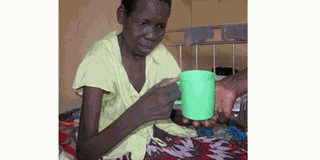Multi-drug resistant TB threatening progress

Christine Asuju,59, has had TB since 2009. She was later diagnosed with multi-drug resistant TB. She is currently on a trial treatment programme by the MSF. Photo by Agatha Ayebazibwe
What you need to know:
Uganda’s 150,000 TB patients are at a risk of a more sensitive case of TB, if they do not adhere to treatment.
Christine Asuju, 59, developed a dry cough in 2009, which was later diagnosed as TB. She was immediately put on a six-month treatment course, after which she was not advised on what to do next and no control reviews were done.
“When my drugs got finished after 6 months, I stopped and the doctors did not ask me to take any tests. A few months passed and I was still coughing. When I went back to the health centre, I was diagnosed with TB for the second time,”she says.
But her treatment was stopped, two months after she lost her sight and became paralysed. She was then asked by medical workers to stop the treatment. Asuju had interrupted her treatment twice and her third test results revealed that her type of TB could not be treated in Uganda. It is multi drug resistant TB (MDR-TB), a type of TB which develops, when first line treatment for sensitive TB has failed.
On the rise
Every year, there are 500 new cases of MDR-TB, according to Health Minister of State, Dr Richard Nduhura. This as the country continues to have a poor TB diagnosis and treatment policy.,
With the current TB drug crisis in the country, experts warn that the number could even rise to 870 new cases of MDR-TB per year, if no efforts are made to minimise the possible causes of this infection.
Although this deadlier TB can be diagnosed in Uganda, it cannot be treated as yet. There is no second line treatment for unresponsive TB. Medically known as line two treatment, it is given after the first line (normal) treatment of six to eight months has failed
The cause
This TB type usually develops during treatment of drug-sensitive TB, Dr Asuman Lukwago, the Permanent Secretary, Ministry of Health says. “Patients fail to complete the full course of treatment, when health care workers provide the wrong treatment, wrong dose or the wrong length of time for taking the drugs, when the supply of drug is interrupted or when the drugs are expired or of poor quality.”
Although the PS says misdiagnosis and overdosing of people with TB, remains the leading cause of this type of TB, Dr Sabrina Sharmin, the Project Coordinator of Doctors without Borders (MSF), in Kitgum, says interrupting treatment by even just two days may be the cause.
A report by MSF; From the Ground Up: Building a Drug Resistant TB Programme in Uganda, shows that 30 per cent of drug-sensitive patients who default treatment, do so because of the high pill burden (from 12 to 36 pills every day) and frequent visits to health centres. Most affected are people in the rural areas who have to walk long distances to the hospitals.
Prevention
The report suggests that TB patients should start treatment very early and that this be administered in their homes to stop more infections. MSF, which is currently the only organisation in the country, providing MDR-TB drugs has had a pilot study since 2007 in Kitgum and Lamwo districts, where it has enrolled 21 patients to build a programme for TB treatment. Community volunteers deliver drugs to these patients and ensure that they take them as is required.
Only patients, who need close medical attention, like Asuju, are admitted to hospitals to avoid infections, given the highly infectious nature of the disease. This is also to minimise the burden under which these patients are sagging because of the disease.The volunteers are trained, given a few incentives like bicycles, washing soap, and Shs10,000 every month, as well as mobile phones to ease monitoring of patients. Patients under treatment are isolated from their families during the course of treatment, and only the volunteers, who are under strict guidelines get close to them.
So far, four patients have successfully completed a two-year MDR-TB treatment and have been ruled out of danger, although they are still being monitored by the organisation. This strategy also suggests that community or home-based health care reduces the risks of MDR-TB.
Treatment
Most patients can barely afford the treatment for the normal TB, which costs between Shs100,000 and Shs200,000, nearly ten times less than the cost of treatment for the MDR-TB.
While Health PS says MDR-TB treatment costs between Shs750,000 and Shs2m, Dr Sharmin, quotes the cost at between Shs12.25m and Shs36.750m per patient for the standard 18-24 month treatment course. This is for drugs procured through the global drug facility but it could be higher for drugs acquired through another avenue.
MDR-TB remains a major public health problem, that threatens any progress made in TB care and control worldwide.




